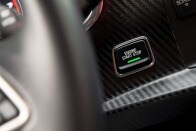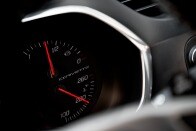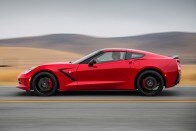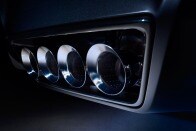Reviews of Chevrolet's all-new 2014 "C7" Corvette Stingray have been rapturous. "Make no mistake, the 2014 Chevrolet Corvette Stingray is a real driver's car," gushed Edmunds.com's own Josh Jacquot upon first driving the new 'Vette. "It hunts apexes with laser-sight precision, clearly communicates its intentions and provides dynamic response on par with far more costly equipment."
But no matter how many superlatives a car may earn — or deserve — it's still just a car. And every car is made up of engineering compromises, styling missteps and ergonomic hiccups. That's right; even the C7 isn't perfect.
So here are 10 things we'd like to change about the new Corvette Stingray. Most of them are nits that need to be picked. After all, we're still gushing over the car.
1. The Taillights — There's no reason why every Corvette should have four round taillights. But there's no reason why the C7 should have taillights that look like Alice Cooper on a bad day, either. The general agreement here is that the tail of the C7 is overstyled and that redesigning the rear lamps would be a good first step toward achieving some aesthetic balance.

2. The Start Button — The Corvette was among the first cars to adopt a proximity sensor and start button in place of a traditional ignition key. But the button in the new Stingray looks agonizingly plain and ordinary. Here you are, the driver, about to ignite a 6.2-liter V8 rated at 460 horsepower in one of the most capable sports cars ever built (a car that tops out at more than 190 mph) and it's about as dramatic an event as turning on the rear window defroster. Shouldn't it be stowed under a protective cover? Maybe there should be a fingerprint reader as on the iPhone 5S? Shouldn't the button be painted with some sort of irradiated coating so it glows menacingly? Shouldn't pressing the start button on this car be exciting and spectacular every single time?
3. "Track Mode" Tachometer — When the Stingray is loaded for hard-core track action, the instrument panel defaults to a large hockey stick-style tachometer that's awkward to read and scan. Centuries of experience should have taught everyone that the most straightforward way to display engine speed is a simple circular dial (whether real or virtual) with a clearly visible needle sweeping across its face. Meanwhile, the circular tachometer used in other modes is great. After all, in the heat of battle, knowing precisely what the engine is turning isn't as important as being able to scan the instrument cluster and make sure the engine is operating within the boundaries of its own limits. And those limits could be marked with something colorful, like a red line.
Yes, this is adjustable so you don't have to use this tachometer in Track Mode, but the hockey stick offends as much in principle as it does in practice. Get rid of it.

4. Oversized Temp and Fuel Gauges — The largest portion of the Stingray's instrument panel is a configurable display directly in front of the driver. It's easy to read and GM has done a great job on the graphics (most of the time). So why are there permanent, redundant and massive temperature and fuel gauges consuming real estate to the right of it? Dump the real gauges and make the screen bigger.
5. The Speedometer — The same criticism that applies to the right side of the instrumentation goes for the left side where a large, permanent analog speedometer lives. Large is an overstatement, actually, since it's still not large enough to easily read the numbers on its face. It manages to be both too big and not big enough. And it's redundant information anyhow, since in most of the configurable screen modes there's a digital speedometer incorporated into the display. Maybe it's time to ditch the analog speedometer altogether.

6. Fender Gaps — The tires on the new Stingray look puny. As in swallowed-up-by-the-fenders tiny. That may be because there are larger-tire versions coming and the car was engineered in anticipation of them. Or it might be that the Corvette needs the room to accommodate snow chains — which isn't something that seems to concern the Italians over at Ferrari and Lamborghini. There are two solutions: Lower the car slightly or install larger-diameter tires.
7. Electronic Parking Brake — Electronic parking brakes are increasingly popular because they package more easily into a car's interior. So bye, bye, big handle; hello, tiny switch. But in a car like the C7, that leads to a disappointing lack of mechanical connection. And in a car like the C7, mechanical connection is everything. Plus it inhibits bootleg turns and other hoon-tastic antics.

8. Too Many Exhaust Outlets — Four exhaust outlets? Four! What is this? A Corvette or a circus calliope? Either cut it down to two or go full badass and add side pipes.
9. Overly Complex PTM Interface — The fact that the C7 has a "PTM Interface" alone makes it seem that in order to drive the car you must first file a TPS report with the new cover sheet. That said, the Performance Traction Management (PTM) system is among the best electronic driver's aids ever built. But getting exactly the right mode for whatever challenge you're undertaking is a pain in the well-upholstered posterior. It's the goofy little dial that selects the modes that drives us nutty. The combination of finger ballet and perfect timing necessary to select your preferred mode is frustratingly unforgiving. Can't we just tune the PTM through our smartphone?
10. Front License Plate — Chevy's got an option to affix a front plate, but it's a $95 kick in the pants and blocks off a good deal of airflow. We don't like either of these things. Since front plates are required in most states, that means either ponying up for the nice one or signing up for a lifetime of fix-it tickets. We'll take the tickets.